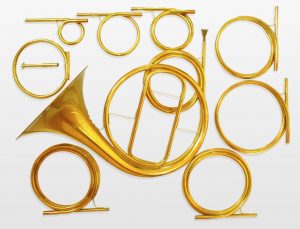In November 1899 the composer and conductor Gustav Mahler (1860-1911) told his friend, the violist Natalie Bauer-Lechner:
“Beethoven’s First, Second, and Fourth Symphonies can still be performed by modern orchestras and conductors. All the rest, however, are quite beyond their powers. Only Richard Wagner and I myself have done these works justice. And even I can manage it only by terrorizing the players; by forcing each individual to transcend his little self and rise above his own powers.”
Mahler goes on to say that:
“Beethoven’s symphonies present a problem that is simply insoluble for the ordinary conductor. I see it more and more clearly. Unquestionably, they need re-interpretation and reworking. The very constitution and size of the orchestra necessitates it: in Beethoven’s time, the whole orchestra was not as large as the string section alone today. If, consequently, the other instruments are not brought into a balanced relationship with the strings, the effect is bound to be wrong. Wagner knew that very well; but he too had to suffer the bitterest attacks because of it.”
Mahler (who, I will gladly confess, is one of my very favorite composers) did not just talk-the-talk but eventually put his pencil where his mouth was and walked-the-walk. (Three tired clichés in one sentence! Am I good, or what! What?) He sat down and “retouched” (re-orchestrated and, to a certain degree, even re-wrote) a number of Beethoven’s symphonies, including nos. 5, 7 and 9, and then performed those “retouched” versions across Europe and in New York City.
Mahler’s “
For example, Mahler argued that if Beethoven had had fully modern valved horns available to him, he – Beethoven – would have written very differently for those horns. In Beethoven’s original score for his Fifth Symphony, he calls for two horns; Mahler added two more horns in his “retouched” score, and employs those four horns in a manner that Beethoven could not, given the limitations of the natural horns available to him in 1808.
In Dr. Bob Prescribes for October 30, I discussed the differences between a natural horn and a valved horn. To review. A modern valved horn, by using keyed valves (or pistons) to automatically change the length of the piping in the horn, is a fully chromatic instrument. However, a natural horn, lacking valves, can only play the pitches of one harmonic series. In 1808, when Beethoven composed his Symphony No. 5, horn players were armed with “crooks”: various lengths of coiled piping that they could plug into their horns, enabling them to play different harmonic series. Changing crooks took time, so typically a player was limited to one crook (and therefore to one harmonic series) per movement.
In the first movement of Beethoven’s Fifth, Beethoven indicates that each of his two horns employ an E-flat crook. In measures 59 – 62, the two horns together play a fanfarish “horn call” in E-flat major that introduces theme two:
When that horn-call returns some minutes later in the recapitulation, it is cast in C major (measures 303 – 306):

Beethoven’s natural horns, what with their E-flat crooks attached, could not play the horn-call in C major. Consequently, here in the recapitulation, Beethoven scored the horn call for two bassoons.
Gustav Mahler claimed that if Beethoven had had modern horns available to him he would have scored that recapitulatory horn-call for horns. So in his “retouched” score, Mahler scores that second horn-call for the horns.
(OMG, what a can of worms Herr Maestro Mahler opens up by doing stuff like this! I mean, should we alter the language in Shakespeare’s plays because we no longer use words like “prithee”, “shrive”, “affy”, and “fardel”? Perhaps we should simply paint over Leonardo da Vinci’s already over-restored The Last Supper with modern paints and acrylic and replace entirely the tempura and gesso with which it was originally painted?
How about we removed the original, gas-guzzling inline six-cylinder engine of classic 1909 Rolls-Royce Silver Ghost and replace it with a modern, more fuel-efficient four-cylinder aluminum engine?)
Okay; before we all work ourselves into a tizzy over what appears to be Mahler’s overweening arrogance, let’s think about this for a moment……





